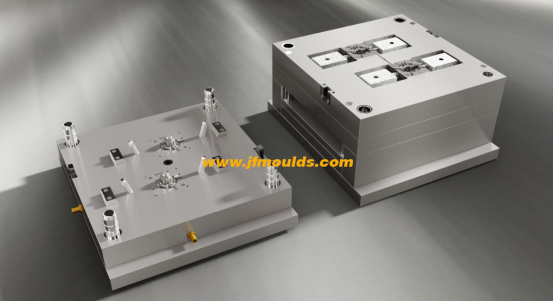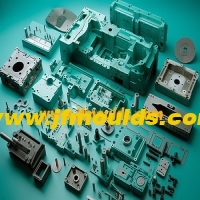Injection molds: From Basic Understanding to Cutting-edge Exploration
Injection molds: From Basic Understanding to Cutting-edge Exploration
I. Introduction
In the vast landscape of manufacturing, injection molds are like a mastermind behind the scenes, quietly yet crucial in shaping every aspect of our lives. In the early morning, when we press the coffee machine button, pick up an electric toothbrush, or put on a Bluetooth headset, behind these daily actions, injection molds are playing a crucial role in transforming plastic pellets into practical and exquisite products. However, today's discussion of injection molds will take you on a profound journey that is completely different from your usual morning cognition, revealing their mysterious veil from a brand-new perspective and exploring their extraordinary value and infinite possibilities in the industrial field.
Car Lamp Mold Manufacturer in China (jfmoulds.com)
Ii. Basic Understanding of Injection Molds
Definition and Essence
Injection molds are precision tools made of metal materials with specific shapes and structures, specifically designed to give molten plastic materials precise shapes and dimensions during the injection molding process. It is like a magical sculptor, except that instead of using engraving knives and clay, it employs high temperature, high pressure and elaborately designed cavities to shape plastic, a highly malleable material, into a wide variety of products that meet people's living and industrial needs. From a micro perspective, injection molds achieve a magnificent transformation from raw materials to finished products by controlling the flow and filling of plastics at high temperatures, as well as the curing and shaping during the cooling process. This process not only requires a deep understanding of the physical properties of plastic materials, but also relies on the precise design and manufacturing process of the mold itself.

Car Lamp Mold Manufacturer in China (jfmoulds.com)
Iii. Working Principle and Process of Injection Molds
(1) Five key steps of injection molding
The working process of injection molds is like a precise and orderly symphony, with each link closely connected and indispensable. Its core process mainly includes the following five key steps:
1. Mold closing and locking: Before the injection molding process begins, the mold closing mechanism of the injection molding machine will tightly close the moving mold and the fixed mold with strong pressure, forming a closed cavity. This process requires extremely high precision. Generally, the mold closing accuracy needs to be within ±0.03mm to ensure the dimensional accuracy and sealing performance of the cavity. Only when the mold is tightly closed can a stable space be provided for the subsequent injection of the plastic melt, preventing plastic leakage and ensuring the molding quality of the product. During the mold closing process, the guiding system plays a crucial role. It guides the moving mold and the fixed mold to align accurately, preventing mold damage or product defects caused by misalignment.
2. Melt injection: After the mold is closed in place, the plastic particles are heated to a molten state in the barrel of the injection molding machine, with the temperature typically ranging from 200 to 300 degrees Celsius. The specific temperature depends on the type and characteristics of the plastic material. Subsequently, driven by the screw, the molten plastic melt is injected into the mold cavity at an extremely fast speed (generally 100-500mm /s) through the runner system. During the melt injection process, the design of the runner system is of vital importance. It is necessary to ensure that the plastic melt can be evenly and quickly filled into every corner of the cavity, avoiding defects such as insufficient filling and weld marks. At the same time, the control of injection pressure and speed also directly affects the molding quality of the product. Excessively high pressure and speed may cause problems such as plastic melt ejection, turbulence, bubble formation, and charring. However, excessively low pressure and speed may lead to defects such as incomplete filling and insufficient product density.
3. Pressure-holding cooling: After the plastic melt fills the cavity, to compensate for the shrinkage of the plastic during the cooling process and ensure the dimensional accuracy and surface quality of the product, it is necessary to hold the plastic melt in the cavity under pressure. During the pressure-holding process, the injection molding machine continues to apply a certain pressure to the plastic melt, enabling the plastic to closely adhere to the mold cavity wall and fill the voids caused by cooling and contraction. Meanwhile, the cooling system starts to work. The circulating coolant takes away the heat from the mold and the product, causing the plastic melt to cool and solidify rapidly. The cooling rate is usually controlled between 5 and 20℃/s. A cooling rate that is too fast may cause stress concentration inside the product, leading to problems such as deformation and cracking. However, a too slow cooling rate will prolong the production cycle and reduce production efficiency. During the pressure-holding cooling process, the temperature distribution of the mold and the uniformity of cooling have a significant impact on the quality of the product. A reasonable design of the cooling system and temperature control can effectively reduce the deformation and shrinkage of the product and improve its quality.
4. Mold opening and ejection: When the plastic product has cooled and solidified to a certain extent, the mold opening mechanism of the injection molding machine starts to work, separating the moving mold from the fixed mold. Subsequently, the ejection system is activated. Under the action of the push plate, the ejector pin pushes the plastic product out of the core or cavity, allowing it to smoothly detach from the mold. During the mold ejection process, attention should be paid to the force and speed of ejection to avoid deformation, damage or difficulty in demolding of the product due to improper ejection. At the same time, to ensure the normal operation and service life of the ejection system, it is necessary to regularly maintain and service it, checking the wear of the ejector pins, the flexibility of the push plate movement, and the reset effect of the reset rods, etc.
5. Cycle restart: After completing one injection molding cycle, the mold and the injection molding machine enter the preparation stage for the next cycle. At this point, the screw of the injection molding machine will return to its initial position, ready for the next conveying and melting of plastic pellets. The mold is reclosed through the guiding system, waiting for the next injection of the plastic melt. The entire injection molding process is a continuous and cyclical production process. By constantly repeating the above five steps, large-scale and high-efficiency production of plastic products can be achieved.
(2) Key technical parameters of injection molds during operation
During the operation of injection molds, several key technical parameters play a decisive role in the quality of the products and production efficiency:
1. Temperature control: Mold temperature and plastic melt temperature are the most crucial temperature parameters in the injection molding process. The mold temperature directly affects the cooling rate of the plastic melt and the molding quality of the product. Excessively high mold temperatures may lead to slow cooling of the product, decreased dimensional accuracy, and surface flow marks, among other issues. However, excessively low mold temperatures may lead to poor fluidity of the plastic melt, incomplete filling of the cavity, and the formation of defects such as cold material spots and weld marks. Therefore, it is necessary to reasonably control the mold temperature based on the characteristics of the plastic material and the requirements of the product. Usually, the precise regulation of the mold temperature is achieved through a cooling system and a heating device. The melt temperature of plastic affects its fluidity and molding performance. It is necessary to select an appropriate heating temperature based on parameters such as the melting point and glass transition temperature of the plastic material to ensure that the plastic can smoothly fill the cavity in the molten state and form high-quality products after cooling.
2. Pressure control: Injection pressure, holding pressure and back pressure are the main pressure parameters in the injection molding process. Injection pressure refers to the pressure required to inject the plastic melt into the cavity, which directly affects the filling speed and filling effect of the plastic melt. During the injection molding process, the injection pressure needs to be reasonably adjusted based on factors such as the shape, size, wall thickness of the product and the fluidity of the plastic material to ensure that the plastic melt can quickly and evenly fill every corner of the cavity. The holding pressure is the pressure applied after the plastic melt fills the cavity to compensate for the shrinkage of the plastic. It has a significant impact on the dimensional accuracy and surface quality of the product. Back pressure is the pressure applied when the screw rotates backward to prevent the backflow of the plastic melt. It can increase the density and uniformity of the plastic melt and improve the quality of the product.
3. Time control: Injection time, holding time and cooling time are the main time parameters in the injection molding process. Injection time refers to the time required to inject the plastic melt into the cavity, which directly affects the filling speed and filling effect of the plastic melt. During the injection molding process, it is necessary to reasonably adjust the injection time based on factors such as the shape, size, wall thickness of the product and the fluidity of the plastic material to ensure that the plastic melt can fill the cavity within the specified time. The holding pressure time refers to the period during which a certain pressure is maintained after the plastic melt fills the cavity. It has a significant impact on the dimensional accuracy and surface quality of the product. Cooling time refers to the time required for plastic products to cool and solidify in the cavity, which directly affects production efficiency and the quality of the products. During the injection molding process, it is necessary to reasonably control the cooling time based on factors such as the thermal properties of the plastic material, the shape and size of the product, and the cooling efficiency of the mold, to ensure that the plastic products can achieve the specified dimensional accuracy and mechanical properties after cooling.
Related News
In-depth Deconstruction of the Injection Mold Industry: Technological Breakthrough, Market Reconstruction and Ecological Dimension Upgrade
2025-07-03
In-depth Deconstruction of the Injection Mold Industry: Technological Breakthrou...
Solutions for air marks at the water outlet position of the mold and drag damage at the water outlet position of the battery frame
2025-08-27
Solutions for air marks at the water outlet position of the mold and drag damage...
Solution for mold fracture and air wrinkle treatment
2025-08-08
Solution for mold fracture and air wrinkle treatmentFracture of the moldPhenomen...
Solutions for air streaks, charring, wire jamming, height elevation or trapped air in molds
2025-08-14
Solutions for air streaks, charring, wire jamming, height elevation or trapped a...
Injection molds: The Cornerstone and Future Trend of Precision Manufacturing
2025-07-12
Injection molds: The Cornerstone and Future Trend of Precision ManufacturingBasi...
How can the surface dirt, water line inclusion and warping deformation of the mold be solved
2025-08-30
How can the surface dirt, water line inclusion and warping deformation of the mo...





